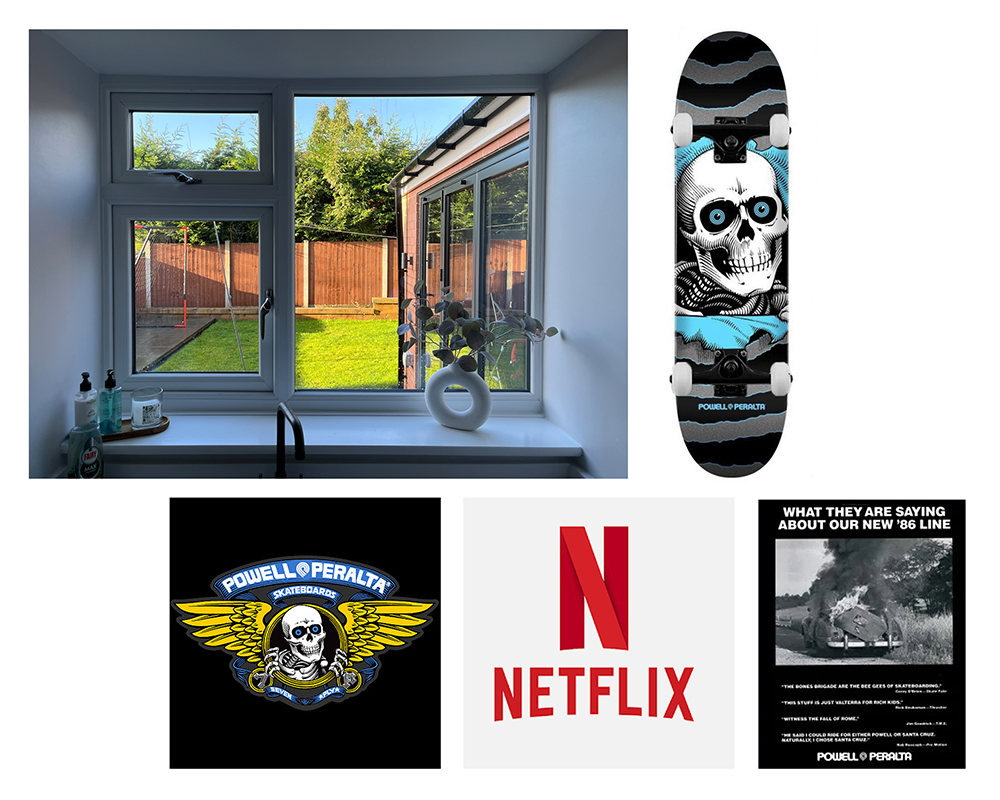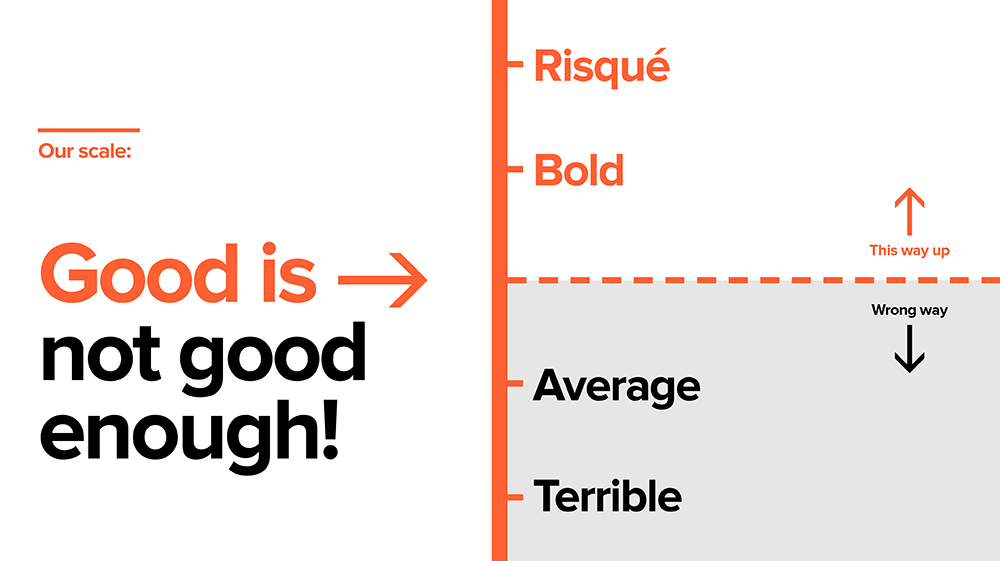Ideas. Everybody has them, but for some of us it’s our job to come up with them. So how do we do it?
Well, as most creatives will tell you, it’s not always that easy. Have you ever suffered from B.P.S.? (Blank Paper Syndrome), or these days as it’s more commonly known ‘Gazing at your computer hoping it will give you the amazing idea syndrome’. Sound familiar?
If you’ve been in the creative industry as long as I have, then you would’ve learned about the different ways you can generate them. If not, you’re either in the wrong job, or you’ve just not figured out how to do it yet.
At Absolute, we have a culture of creating ideas. We know a lot of great creative agencies who prefer to be more style driven. That’s fine. It’s their approach, but we try to include at least one great idea in every project. We truly believe that if a brand, or campaign, has a strong idea, then it will have the edge against the competition, because it will make it more memorable.
So, whether you’re just starting out, still early in your creative career, or a long timer who’s still after that elusive great idea, here are some ways that can help you. And some examples of how we came up our ideas.
Why knowledge is key
This is the most important part to creating ideas. By knowing more, you massively increase your chances of landing a great idea. Read books. Not just creative books, but all sorts of literature. If you do want to read a creative book, then there’s none better than ‘Smile in the Mind’. This book is packed full of original and witty ideas for inspiration. Don’t yoink (steal) them though! We’ll talk about that later.

Alongside reading books, take more interest in the news and what’s going on in the world. Visit a museum, or attend a talk or event. Immerse yourself in music and fashion. Take part in different sports, or just watch sports. Travel. Then travel some more. Try your hand at DIY. Watch films, TV, adverts or even TED Talks – there’s hundreds of subjects covered. There’s even a great one on ‘Procrastination’, so don’t put off watching it.
The point here is, the more you do, and learn in life, the more interesting you’ll become and you will also find it much easier to create ideas. Good ones. And even greater ones. What you learn today may not help you now, but you’ll be ready when you have a problem to solve. That might even be in 10, 20, or 30 years time. In my experience, virtually everything I’ve done or learned in life has ended up in a project, one way or another.
Here’s a perfect example of what I’m talking about when we received a brief from Swifty to promote a range of cool adult scooters:

As a kid, I was obsessed with skateboarding. The tricks. Half pipes. Quarter pipes. Ramps. I loved the new style boards of the 80’s, which had the cool illustrations on them. I was always trying to create my own versions of them. I remember flicking through the magazines like ‘Thrasher’ and pouring over the board designs and the advertising.
Years later (many years later), I was watching a Netflix documentary on how Powell Peralta Skateboards had hired a Creative Director to boost sales. His vision was never to show the skateboards. They set fire to cars instead (which I wouldn’t recommend). This was all about creating an attitude for the brand and it was a brave move that succeeded.
Swifty Scooters are made of stern stuff. They can be pushed to the limits. So I started to think of how we could promote this, without showing much of the products.
The idea came whilst washing up at home. The best ones usually arrive when you’re not sat at your desk (more about this below). I was looking out of the window and thinking about the frame as the edge of the advert. Then it hit me. Why don’t we just show a bit of the scooter going out of frame.

The Swifty Air is designed for stunts. The Swifty Zero is designed for speed. Advertising is all about exaggerating the truth, so this concept was perfect for communicating the extreme nature of the product and letting it speak for itself. Cue the sketches.

The final outputs didn’t really need a clever copy line, although we’d considered one. We felt that the images were more powerful by themselves and the brand name does the rest.


When do ideas appear?
Like the Swifty Scooters adverts, ideas can appear anytime or anywhere. If you’ve understood the problem you’re trying to solve and you’ve done your research, then it’s time to get away from your desk. If you don’t, you could end up suffering from Blank Paper Syndrome.
My advice is to go for a walk. Or walk with someone else and talk about it. Sleep on it, your mind will be clearer in the morning. Make a brew. Go to the toilet. Clean the car. Do some exercise. Or even wash up. You will find that whilst your mind is relaxed and you let it wander, you’ll find the solution will appear much quicker. It worked for Archimedes when he had his “Eureka!” moment in the bath.
Sometimes the solution can appear whilst doing some home DIY. This is what happened when we received a brief from Redrow to promote their new homes:
I’ve spent a lot of time over the years on home renovation, with DIY projects big and small. It can be rewarding when it all goes to plan, but a pain when it doesn’t. I was in the middle of refitting my bathroom when we started to work on a national campaign for Redrow.

Before we were given the brief, we’d been invited to a Redrow agency day. During this day, their Marketing Director was talking about the nations obsession with renovating older properties. He phrased his presentation as ‘Skips on Drives’, which stuck with me. More so, as I’d had plenty of first hand experience on the subject. Not only that, I’d also watched a lot of the DIY programmes on TV. The majority of the shows were on Channel 4 too. I think they’d cornered that audience.
The strategy was pretty clear and the data backed it up too. Let’s focus on targeting the second hand market audience. It made sense as 86% of all housing transactions in the UK were on older properties. A lot of people are sold the dream by TV and you’ll often hear the presenter say; “It’s a do’er up’er!” when viewing a run down property with a couple.

Our idea – let’s show the audience how messy, stressful, and more often than not, how disastrous and expensive it can be too. We’ll put them off by showing them the problem, then show them a great solution – a brand new Redrow home.
We focused on the 3 main audience types: families looking to extend their homes (video above), first time buyers looking for a ‘Do’er up’er’ and older couples who are thinking of downsizing once their children had left home ‘Living the Xmas Misery’.
The campaign was rolled out on regional TV, online and across various social media channels. The results were great and the client was really happy.
Benchmarking your idea
It’s alright having an idea, but is it any good? We like to think that we have a minimum requirement of ‘good’ with all our projects at Absolute. But, is ‘good’ ‘good enough’?
The thing with coming up with ideas is, how do you know if it’s good enough? What’s the benchmark? And worst still, has it been done before? In terms of the latter, there is rarely any originality these days. Most ideas have already been done. That doesn’t mean you can yoink ideas. You have to think of an idea and then check, usually on the internet, whether it’s been done before, for a similar project, in the same sector.

The best ideas are the ones that look new, fresh and relevant to the current environment they sit in, grabbing the attention of the viewer. Be careful though. Some brilliant ideas have been ruined by very poor execution. Remember, craft can turn a good idea into a great one.
Now we’ve cleared that one up, how do you know the idea is good enough?
You could seek the opinion of people who you respect and who know what they’re talking about. You could scour the creative industry award websites to see what ‘great’ looks like. You could also enter the awards (the best ones), which usually means paying a big fee, then being at the mercy of the specially selected panel of judges. If you do pick up a nomination, or a win, then brilliant, you know you’re in the right place and mixing it up with the best in the industry.
As a creative, if someone shows you their idea and you react with “I wish I’d thought of that”, then that’s usually a good gauge of ‘good’. A word of warning though, there are fellow creatives out there who will scoff at your idea because they didn’t think of it, or they’re jealous, or just don’t want you to succeed. Sometimes they’ll steal your idea and pass it off as they’re own. Choose your judges wisely.
Refreshing ideas
Here’s a funny idea, or prank, that most people throughout the world have heard of, or been on the receiving end of, at some point in their lives: 
Have you ever been sent on a ‘Fool’s errand’ by your parents, mates, or by your work colleagues in the early days of your new job? “Can you go and get me a left-handed screwdriver?”, or “Buy a glass hammer for the windows”, or even “Go down to the store and ask for a tub of elbow grease”. I think you get the idea.
Our long trusted print supplier, and client – NB Colour Print in Chorley – wanted to promote their speciality printing to all the creative agencies around the North West of England. We had a lot of fun working on various promotional items for them, but an opportunity came up that we couldn’t resist. April Fool’s Day was fast approaching and we wanted to help NB take advantage of it.

The well-known prank of sending someone out to buy some ‘Tartan Paint’ or ‘Polkadot Paint’ felt perfect in promoting their speciality and vibrant colour printing. So, as I mentioned earlier “The best ideas are the ones that look new, fresh and relevant to the current environment they sit in, grabbing the attention of the viewer.”. This wasn’t a new idea, but a fresh take on an old concept. Perfect.
Don’t yoink!
And finally, the most important point. You should never blatantly steal anyone’s ideas. Especially in this digital age that we live in. You’ll soon get found out.
To illustrate my point, here’s an agency who were outed on LinkedIn not so long ago:

It doesn’t get anymore blatant that this. It’s not that it’s a juxtaposition concept of joining 2 images together. Most creatives have tried this approach, including myself. It’s the fact that it’s for a similar rubber sole company. Not only that, it is clearly a straight copy of each and every variation of the concept! They did try and change the headlines though. Who were they kidding? How did they think they’d get away with it? Just fools to themselves and their client. There’s no way in the world that’s a coincidence.
Speaking of coincidences. A few years ago, we were asked by our client, Toffeln, to help them promote a range of shoes that had been specifically designed to alleviate foot fatigue for nurses who work long hours. We came up with the idea of sending out the shoes to key influencers in the health sector. Our influence for the concept came from packs of pain relief capsules and the Spiritualized CD’s (remember them?) which were packaged up in an oversized prescription tablet pack.

We produced a range of promotional shoe boxes that resembled pain relief packs, that had the sample shoes freshly housed in foil sealed containers. The message was clear. It was a great idea that would definitely not go unnoticed. Perfect. It had the desired effect when each one was delivered to the influencers. The client promoted the campaign and so did we on the usual online creative channels.
Roll on a few years, we spotted a PR piece on LinkedIn from a well known creative magazine. Another creative agency had produced a similar idea for Asics. Was this a yoink? Was it a lucky coincidence? We’re not so sure. Did they think that just because our idea was for a brand that wasn’t as well-known as theirs, they could get away with it? We’ll let you decide on that one.
Along with all the reaction they were getting on LinkedIn, we felt obliged to highlight that we’d done the same concept a few years earlier. Were they bothered? I’m not so sure. Did we feel better for outing them? Of course we did.
I will acknowledge though, one of the toughest parts about being in the creative industry, is thinking you’ve come up with a great idea, then discovering it’s been done before. It happens to the best of us. You have to move on quickly and work harder to produce something a lot better.

Final thought
Whether you’re a creative, or client, reading this article, it should give you a good insight into what it takes to generate ideas and the process we go through. It can be very rewarding when a great idea is accepted by everyone and it resonates with your audience. It can also be very challenging when you struggle to find a solution, or when you discover that an idea has been done before. If you take onboard the main point about soaking up as much knowledge as possible, then hopefully you’ll never struggle to create loads of great ideas.